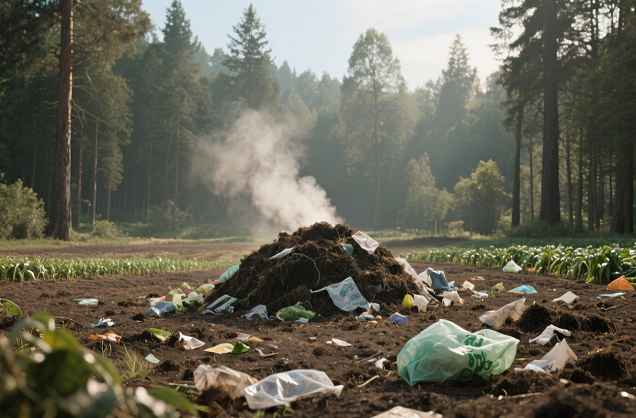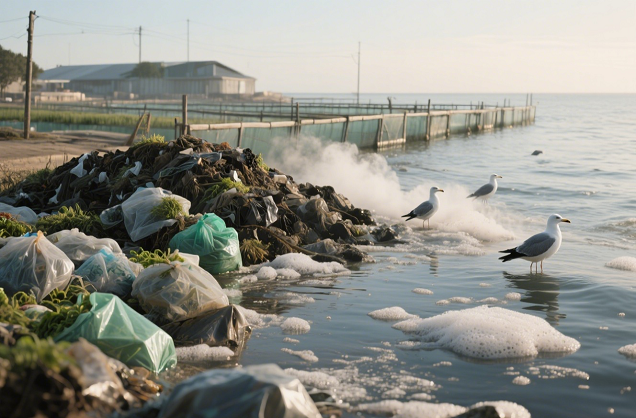Composting increases carbon emissions instead? A situation most people don't know about?
Is the environmental myth of composting busted?
In recent years, composting has been widely touted as the ultimate solution to “zero-waste living”. However, under the wrong conditions, composting can produce more greenhouse gases than landfills and even exacerbate climate change, according to the latest scientific research.

In 2024, a UC Berkeley study found that:
30% of home composting systems actually increase carbon emissions due to mismanagement
Some “compostable plastics” emit methane (CH₄), which has a greenhouse effect 25 times greater than that of CO₂, in an oxygen-poor environment.
Part 1: Why does composting increase carbon emissions?
Scenario 1: Anoxic composting (methane production)
✅ Healthy composting (aerobic decomposition):
Microorganisms convert organic matter to CO₂ + water + humus
Carbon emissions: 0.1kg CO₂e/kg compost
❌ Anoxic composting (anaerobic decomposition):
Anaerobic bacteria dominate, methane (CH₄) is produced
Carbon emissions: 2.3kg CO₂e/kg compost (23-fold jump)
Common mistakes:
Compost bin completely sealed
Material too wet and not turned
Scenario 2: Incorrect material mixing (contaminated soil)
Type of material Problem Alternative
Industrial grade PLA plastic Does not decompose in home composting Recognize OK Compost HOME certification
Meat/dairy products Produces odor, attracts pests Bokashi composting only
Herbicides residues on plants Poison beneficial microorganisms High temperature composting treatment alone
Test case:
A family put “ industrial grade PLA” tableware into the compost after 6 months and detected microplastic residues that contaminated the entire batch of compost. A family composted “Industrial Grade PLA” tableware, and after 6 months, microplastic residues were detected, contaminating the entire batch of compost.
Scenario 3: Low temperature composting (cannot inactivate pathogens)
Ideal temperature: 54-65°C (lasts for 3 days to kill pathogens/weed seeds)
Reality:
Small compost bins are only 30-40°C
Undecomposed pathogens enter the soil with the compost
Research data:
Soil Association tests in the UK have shown that 42% of home composts contain E. coli in excess of the limit.
Scenario 4: Centralized treatment over long distances
Centralized composting plant:
Trucks are needed to transport the waste, generating 3.2kg CO₂ per tonne
Decentralized local composting:
Carbon emissions are reduced by 80%
Typical case study:
A city has introduced centralized composting of food waste, but because of the long distances involved in transporting the waste, the carbon footprint has exceeded that of landfill.

Part 2: 5 Tips to Make Composting Truly Low-Carbon
Option 1: Forced Ventilation Design
DIY Retrofit:
Drill holes in the side walls of the compost bin (1cm in diameter, 10cm apart)
Insert PVC pipes for ventilation ducts
Effect: 90% reduction in methane emissions
Option 2: Precise Control of Carbon to Nitrogen Ratio
Golden Ratio of 25:1:
“Green Materials” (Nitrogen Sources): Food waste, coffee grounds
“Brown materials” (carbon source): dried leaves, cardboard
Simple judgment method:
Materials should be like a wrung-out towel - moist but not dripping
Option 3: Temperature monitoring + turning
Tools recommended:
Compost thermometer ($15-30)
Turning the heap once a week
Data reference:
Temperature range Decomposition speed Sterilization effect
<40°C Slow None
40-50°C Moderate Partially
>50°C Fast Completely
Option 4: Localized Processing
Scenarios:
Community Shared Composting Stations (5-10 households)
Balcony Vermi-composting (suitable for condominiums)
Carbon Reduction Effect: 87% less than centralized processing
Option 5: Careful Selection of “Compostable” Products “Compostable” products
Safe choices:
Certified home composting (OK Compost HOME)
Ingredients are PLA/PBAT/PHA only
Lightning checklist:
“Oxo-degradable” plastics
Products not labeled for composting conditions

Part 3: Future Trends - Smart Composting Solutions
1. IoT Composting Bins
Functions:
Real-time monitoring of temperature/humidity
APP to remind turning time
Representative products:
Lomi ($499 with crushing+heating function)
Reencle (made in South Korea, 24-hour fast composting)
2. Community Composting Blockchain
Mode of Operation Residents are rewarded with tokens for dropping off food waste
Composting data is uploaded to the chain to ensure real emissions reductions
Pilot cities:
Amsterdam (launch in 2023)
Shanghai's Foreshore community (test in 2024)

 Significant progress in PBAT/s
Significant progress in PBAT/s
 PLA/PBAT composite film degrad
PLA/PBAT composite film degrad
 A New Choice for Takeaway Pack
A New Choice for Takeaway Pack
 Significant progress in PBAT+s
Significant progress in PBAT+s
CONTACT
Add: Room 4006, No.1 Helong Yiheng Road, Baiyun District, Guangzhou City
Tel: +8613450255948
Wechat : +86-13450255948
Fax: +86-13450255948
E-mail: 13450255948@163.com








